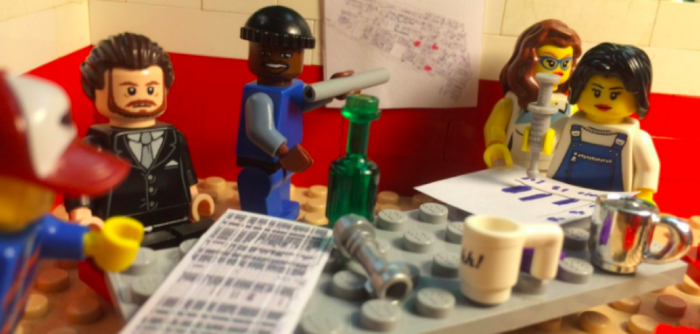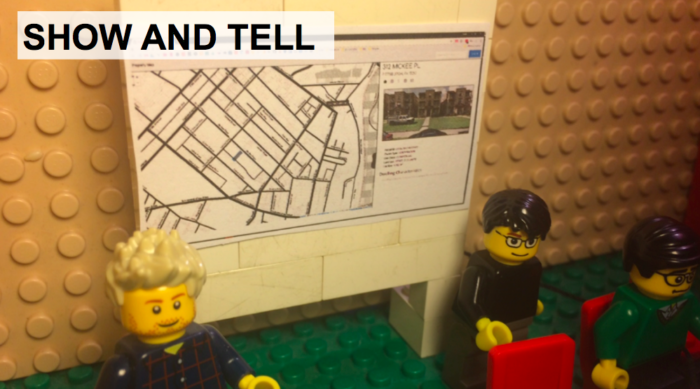How hosting user groups for open data helps cities

This spring, Sunlight’s Open Cities Team is researching how city governments can improve connecting open data to the lives of their residents.
One promising approach that we recently had an opportunity to observe first-hand is a model for creating and nurturing “Data User Groups.”
In the following post, we explain what these groups are, how they work, how you can adopt and adapt them in your municipality, and other key takeaways from our trip to Steel City.
What are Data User Groups?
As with every story of urban innovation, this story begins with a human who had an idea to make government work better: Bob Gradeck. He was gracious enough to allow Sunlight to sit in on two recent data user group meetings, one featuring transportation data and another showcasing property and housing data. (He also let us use all of his whimsical Lego illustrations in this post.)
Gradeck runs the Western Pennsylvania Regional Data Center (WPRDC) in Allegheny County. The center publishes open data from sources around the Pittsburgh region, including Allegheny County, the City of Pittsburgh, the University of Pittsburgh, Carnegie Mellon University, other public sector agencies and local nonprofits.
After WPRDC launched, Bob Gradeck began hosting a series of Data User Group Meetings, spearheading a new approach to engaging the residents of Allegheny County and beyond. Each of these meetings was focused on a particular type of data released online, from health to transportation.
Gradeck created a space that allows data users and providers to meet one another, share what they’ve learned about the topics and relevant data, and collaborate on new projects. The meetings provide the WPRDC with useful insights about setting priorities for releases, identifying opportunities to adopt data standards, improve quality, and design visualizations, APIs, dashboards, or other tools that improve disclosure and reuse of data by the public.
The WPRDC team follows these meetings with the creation of data user guides that are directly informed by the conversations captured in the user group meetings. Each guide provides more detail for people who want to use data, including why a given data set was collected and tools that apply it. The guides are a useful way to ease people into the process of using data and providing inspiration for use.
The transportation user group meeting we attended kicked off with a presentation by a representative from a data contributor to WPRDC, HealthyRide, who discussed how Pittsburgh’s bike share system uses data to measure performance and strategize improvements to the system. The attendees then participated in exercises exploring potential outcomes applying data and mapping the activities, data, and tools needed to achieve these outcomes.
The following day, we joined over 30 people gathered to hear about progress on collecting and releasing property and housing data. Attendees participated in a card sorting exercise that informed future features for a property mapping tool the WPRDC is developing.
Reusable lessons from Pittsburgh’s data engagement efforts

We had a great time capturing the dynamics of these events. We’ve shared several key lessons below so that you, too, can host your own data user group meeting.
- You can’t replace face-to-face interactions. In-person meetings bring a human element to the tasks you’re trying to accomplish together. It’s much easier to convey an emotion — such as enthusiasm for a certain project or frustration over data quality — in person than it is staring at a screen. These meetings can help build rapport and identify opportunities for collaboration. Further, convening your community will help build greater trust and understanding for the users of your open data. Together, these elements can support reuse of open data. Find an offline space (check your local library!) to gather data enthusiasts and issue experts together.
- We <3 icebreakers! Introductions and other group activities help mix things up. People don’t love being talked at for two straight hours or staring at PowerPoints all day. Bring a group activity to your meeting or a show-and-tell featuring a great tool that someone created using the data. Who knows, you might end up playing matchmaker for a data collaboration!
- Snacks. I can’t place enough emphasis on this, but I’ll try: BRING SNACKS.
- Follow up. The WPRDC team follows up after each data user group meeting, creating a virtuous feedback loop. They send recap emails featuring roadmaps for each topic that include data wish lists, share tools they’re working on, slide decks, and other meeting details. The team also sends out monthly newsletters to inform attendees of updates to the data.
- Ask for feedback. At the end of each session, request that your attendees fill out a survey to capture feedback for improving the meeting series — or share one online afterwards. User experience matters.
- Everyone is welcome! User group meetings aren’t just for the “data geeks” and “tech nerds.” Anyone who has an interest in the topic is welcome. These meetings are for folks who care about local issues to identify ways to use data to do good. For example, if you’re organizing a meeting for users of environmental data, find local conservationists, gardeners, hikers, and fellow water drinkers and ask them to stop by. Choose a day and time for your user group meeting that’s reasonably convenient for the public.
- This model is replicable almost anywhere. We hope the WPRDC approach spreads like wildfire. We’ll publish a detailed case study of the work being done in Pittsburgh, including information about the people and tools that make up the region’s open data program later this year. Stay tuned!
- Pittsburgh is great! The city is home to beautiful bridges, two funiculars (or “inclines”, if you’re so inclined), and the Pittsburgh Banjo Club plays a free show every Wednesday evening!
In sum, Pittsburgh has piloted a robust model for sharing data with people from across the community to foster meaningful engagement.
That’s news worth sharing — and we hope you do.

